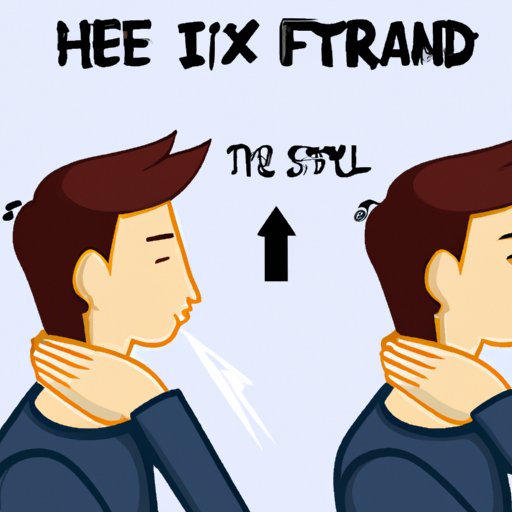
Introduction: What is a Stiff Neck?
A stiff neck is a common condition that occurs when the neck muscles become tight and painful, making it difficult to move the neck. It can be caused by a variety of factors, including poor posture, muscle strain, and injury. While a stiff neck may be uncomfortable, it’s usually not a serious problem and can be effectively treated with some simple techniques and tips.
In this article, we’ll explore some effective ways to fix a stiff neck, including self-massage techniques, stretching exercises, heat and cold therapy, medications, correct posture, and seeking professional help if necessary.
Self-Massage Techniques
Self-massage is a great way to reduce muscle tension and stiffness in the neck and upper back. It’s also a convenient and cost-effective way to treat a stiff neck at home.
To perform a self-massage, start by sitting in a comfortable position with your back straight. Use your fingers to massage the muscles on either side of your neck, starting at the base of your skull and working your way down to your shoulders. Apply gentle pressure and circular motions to help release any knots or tension in the muscles.
You can also use a tennis ball or foam roller to massage the area. Place the ball or roller under your neck and roll it up and down, applying pressure as needed.
Remember to take your time and be gentle when massaging the neck and upper back. Avoid applying too much pressure or massaging the spine.
Stretching Exercises
Stretching is another effective way to loosen up tight muscles and reduce stiffness in the neck and upper back. It can also improve flexibility and range of motion in the neck.
Start by sitting in a comfortable position with your back straight. Slowly tilt your head to the left, bringing your left ear towards your left shoulder. Hold for 10-15 seconds, then return to the center. Repeat on the right side.
Next, tilt your head forward, bringing your chin towards your chest. Hold for 10-15 seconds, then slowly return to the center. Finally, tilt your head backward, looking up at the ceiling. Hold for 10-15 seconds, then return to the center.
You can also perform shoulder rolls to help reduce tension in the neck and upper back. Roll your shoulders forward and backward in a circular motion, stretching the muscles as you go.
Heat Therapy
Heat therapy is a great way to reduce muscle tension and stiffness in the neck. It can also improve blood flow to the area, promoting healing and reducing pain.
You can use warm compresses or hot showers to apply heat to the neck and upper back. Simply place a warm compress or towel on the affected area for 10-15 minutes, or take a hot shower and allow the water to run over the affected area.
Remember to avoid applying heat for too long or using heat therapy if you have a fever or an open wound in the affected area.
Cold Therapy
Cold therapy can also be effective in treating a stiff neck, especially if the stiffness is caused by an injury or inflammation.
You can use cold compresses or ice packs to apply cold therapy to the neck and upper back. Simply place a cold compress or ice pack on the affected area for 10-15 minutes at a time, several times a day.
Remember to avoid applying cold directly to the skin, as this can cause skin damage. Always wrap the cold compress or ice pack in a cloth or towel before applying it to the skin.
Medications
If your neck stiffness is accompanied by pain, over-the-counter medications such as pain killers and muscle relaxants can be effective in reducing discomfort.
It’s important to follow the dosage and instructions for use carefully and to avoid taking more than the recommended amount. You should also be aware of any possible side effects or interactions that may occur.
If you have any questions or concerns about using medication to treat your neck stiffness, be sure to consult your doctor or pharmacist.
Correct Posture
Correct posture can help prevent neck stiffness and reduce pain and tension in the neck and upper back.
To maintain good posture, sit up straight with your shoulders back and your chin tucked in slightly. Avoid slouching or leaning forward, and keep your computer monitor at eye level to avoid straining your neck.
You can also perform exercises to improve posture, such as shoulder blade squeezes and chin tucks.
Seek Professional Help
If your neck stiffness is severe or persists for more than a few days, it’s best to seek professional help. A physiotherapist or chiropractor can provide specialized treatments to help reduce pain and stiffness in the neck and upper back.
When seeking professional help, be sure to choose a qualified practitioner with experience in treating neck stiffness. Ask for recommendations from friends or family members, and check the practitioner’s credentials and reviews online.
Conclusion
A stiff neck is a common condition that can be treated effectively with some simple techniques and tips. Self-massage, stretching exercises, heat and cold therapy, correct posture, medication, and seeking professional help are all effective ways to reduce pain and stiffness in the neck and upper back.
By using these techniques and tips regularly, you can help prevent neck stiffness and maintain a healthy, pain-free neck and upper back.




